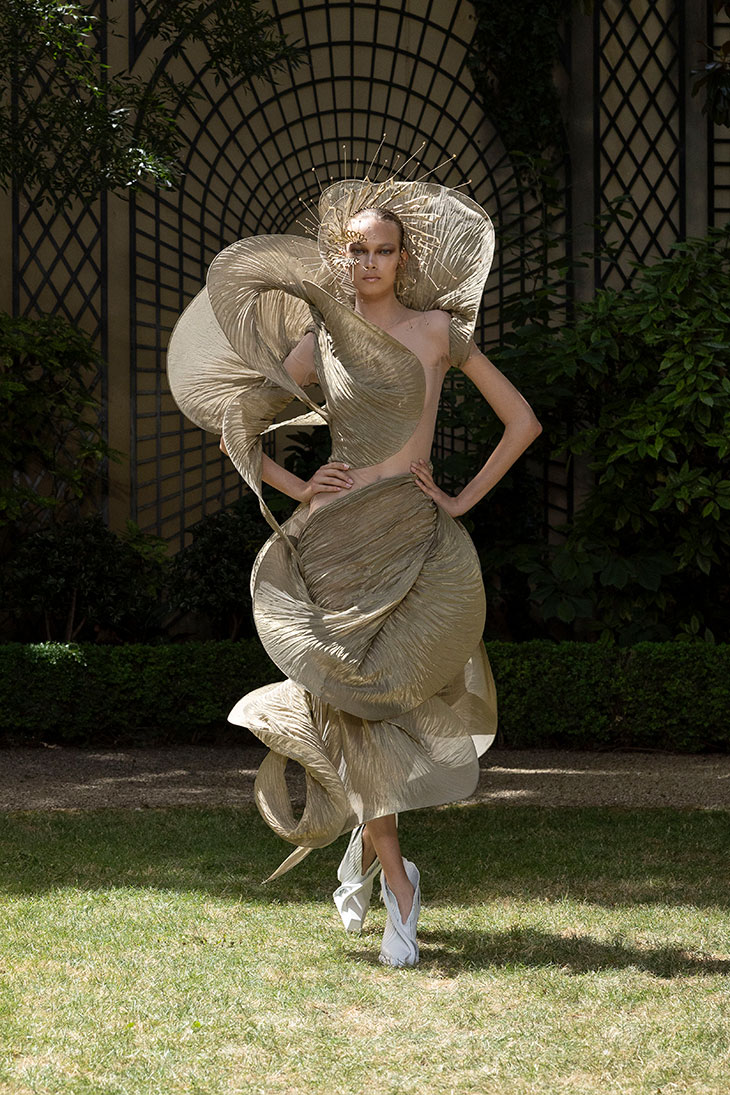
Iris van Herpen, the visionary fashion designer, unveiled the latest collection at the Paris Haute Couture FW23, drawing inspiration from the realms of Aquatic Architecture and Bionic Innovations. The collection offered a captivating glimpse into a future where humans seamlessly coexist with both land and offshore environments, creating a harmonious relationship between humanity and the world’s oceans.
Van Herpen embarked on a creative journey inspired by the visionary ideas of Jacques Rougerie, a French Architect and Oceanographer known as the ‘Architect of the Sea.’ Rougerie’s work, which bridges the gap between scientific exploration and architectural innovation, provided a deeper understanding of the intricate relationship between the oceans and our built environment. His designs of underwater habitats and floating laboratories, informed by his expertise as a marine biologist and architect, sparked van Herpen’s exploration of aquatic urbanism.

The collection also drew inspiration from the revolutionary World’s First Floating City, ‘Oceanix,’ currently under construction in South Korea. Designed by renowned architect Bjarke Ingels, Oceanix integrates zero waste and circular systems, closed-loop water systems, net-zero energy, and coastal habitat regeneration. The innovative concepts of Vincent Callebaut, such as ‘Lilypad’ and ‘Oceanscrapers,’ further influenced van Herpen’s technique development. Callebaut’s ocean architecture projects focus on sustainable living, environmental preservation, and the creation of self-sufficient ecosystems that thrive both above and beneath coastal waters.

Driven by research and development, the collection materialized the principles of parametric architecture, known for its fluidity, fragmentation, and shifting patterns. The designs exuded dynamic energy, with explosive patterns of light and shadow that vibrated around the body, fractal forms, geodesic voids, and distorted perspectives that pushed the boundaries of traditional fashion.

Van Herpen’s exploration of aquatic urbanism led to the creation of new couture techniques that blurred the boundaries between fashion and floating architecture. The ‘Biophilic’ technique involved laser-cutting architectural lineworks, bonding them together as molds, and injecting marble-textured silicone into the fine laser-cut outlines. Abalone-shell flakes were meticulously inlaid by hand, creating graceful gradients within the silicone.

The daring ‘Oceanix’ technique showcased bursting patterns in space, with graphic polygon patterns dynamically transitioning from order to chaos as the models moved, deconstructing the polygons in the air. Fine fiberglass rods balanced weight and vibration, bringing the dissected geodesic bursts to life and creating an interplay of fluidity and fragmentation.
Another captivating technique in the collection was the ‘Sensorama,’ crafted from 0.7mm brass that underwent waterjet-cutting, buffing, polishing, and meticulous folding by hand. These 3D fractal mineral formations were then laser-welded layer by layer, resulting in mesmerizing structures.

The harmonious color palette reflected the oceanic mood, combining graphic contrasts of white and black with metallic silver, bronze, and gold detailing. Soft tones of mint-green mixed with abalone-blue, turquoise, and pearlescent shell shades further enhanced the collection’s aquatic inspiration.
Completing the looks were the architectonic ‘Bionic’ boots, digitally modeled and 3D printed in collaboration with Scry, along with ethereal bejeweled face jewelry created in partnership with Malakai and Rinaldy Yunardi.

The ‘ARCHITECTONICS’ collection boldly envisioned a future of waterborne urbanism, where humanity harmonizes with marine ecosystems. As global concerns mount regarding rising sea levels and the vulnerability of large cities, van Herpen’s designs drew attention to the visionary ideas of Oceanix and the new generation of architects showcasing the desirability and ingenuity of waterborne architecture. Each design encapsulated the duality of our existence, seamlessly blending the realms of land and water.
Behind the concept, bionic architecture emerged as a science that draws inspiration from the complex interactions between biological systems and their environment. Architects aim to design self-sufficient structures that respond to internal and external forces, fostering a harmonious relationship between nature and society. By understanding and emulating the ways biological systems adapt, architects create buildings that structurally modify themselves and incorporate biomimetic materials for sustainable living.
Iris van Herpen’s collection not only showcased her avant-garde creativity but also offered a thought-provoking exploration of a future where fashion and architecture merge, presenting a stunning vision of Aquatic Architecture and Bionic Innovations that captivated the audience at Paris Haute Couture FW23.




















